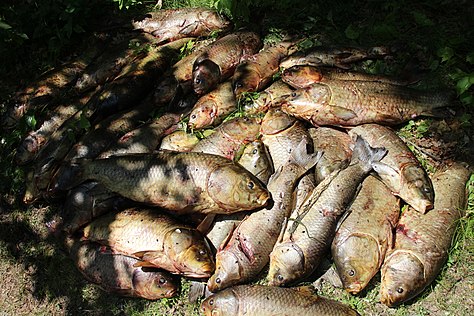Bigmouth buffalo
[2][3][4][5][6] It is the largest North American species in the Catostomidae or "sucker" family, and is one of the longest-lived and latest-maturing freshwater fishes, capable of living 127 years and reproducing infrequently.[6] Like other catostomids it has a long dorsal fin, but unlike all other extant species it has a terminal (forward-facing) mouth reflecting its unique, pelagic feeding ecology.[2][3][4][5][6] A 2019 study documented and validated their late maturity, centenarian longevity, and that several populations in northwestern Minnesota are composed mainly (85–90%) of individuals more than 80 years old, indicating recruitment failure since the 1930s.[3] A 2021 study from North Dakota also revealed a slow pace of life including late maturity, decadal episodic recruitment, declining population, and a relatively large group of old-growth individuals.[4][3][6] Such long-lived species require time to successfully sustain themselves by surviving to periods in which favorable environmental and biotic conditions arise for booms in reproduction and subsequent recruitment through the predation gauntlet.For example, a 2024 study[6] set in eastern Minnesota analyzed the exploited population of bigmouth buffalo and their spawning migration at Rice Lake National Wildlife Refuge across several years.[6] With a median age of 79 years as of 2024, and greater than 99.7% of individuals hatched before 1972, these bigmouth buffalo at Rice Lake National Wildlife Refuge comprise one of the oldest known populations of animal on earth.[5][3][26][30] Native Americans utilized bigmouth buffalo, Lewis and Clark harvested them on their journey in 1804, and the inland commercial fishing industry has valued them as a prized catch since the 1800s.[31] Though it has small bones suspended in its muscle tissue like northern pike, its good flavor makes it one of the most valuable of the traditional, non-game freshwater fish.In addition to being a foodfish, the bigmouth buffalo has recently become a sportfish as catch-and-release anglers have learned to pursue them on rod-and-line,[12][32][33] and as lethal bowfishing has also increased in the 21st century.[36] The juveniles and adults are mostly limnetic plankton feeders that also eat cladocerans, copepods, algae, chironomids, ostracods, and other insect larvae and invertebrates depending on availability.[3][5][12][4] Bigmouth buffalo have a tendency to accumulate unique pigmentation (orange and black spots) as they age,[3][22][12][6] which may vary by habitat variables such as water quality and available food.[46] The bigmouth buffalo is also negatively affected by dams that restrict their movement and ability to find suitable spawning habitat, they are prone to winterkill, and they are highly vulnerable to overfishing.[6] A reflection of outdated fisheries management, harvest limits on bigmouth buffalo do not exist in these same areas - this despite the rapidly growing new sport of modernized night bowfishing that exploits this species.[4][2][6][3] Overall, the International Union for Conservation of Nature did not consider bigmouth buffalo to be at risk of extinction in its 2013 assessment,[1] which came before recent developments in the understanding of the life history of Ictobius cyprinellus.[52] In Omaha, Nebraska, Joe Slavic caught a 64-pound (29 kg) bigmouth buffalo using mulberry bait on June 8, 2000 in a Dodge County sand pit.[53] The International Game Fish Association all-tackle record stands at 31.89 kilograms (70.3 lb), caught on April 21, 1980 by Delbert Sisk in Bastrop, Louisiana.




Conservation statusLeast ConcernIUCN 3.1Scientific classificationEukaryotaAnimaliaChordataActinopterygiiCypriniformesCatostomidaeIctiobusBinomial nameValenciennesSynonymslongest-livedcontinentsdorsal finpelagicbuffalofishescentenarianrecruitmentSaskatchewansupercentenarianbowfishingsturgeonpaddlefishNational Wildlife Refuge systemUnited States Fish and Wildlife ServiceRice Lake National Wildlife RefugeRed River of the NorthManitobaNorth DakotaOhio RiverMississippi RiverAlabamaMilk RiverAlbertaQu'Appelle RiverLake WinnipegCaliforniaLos Angeleswalleyenorthern pikecatfishalligator garfilter-feedzebra musselsmolluskveligerbigheadsilver carpcommon carpinvasive speciesNative AmericansLewis and Clarkbuffalo ribsbenthiccopepodscladoceranschironomidssmallmouth buffaloslimneticostracodslake sturgeonteleostbomb radiocarbon datingotolithCommittee on the Status of Endangered Wildlife in CanadaSpecies at Risk ActchannelizationturbidityNelson Riveranchor parasitesEpistylisFlavobacterium columnareInternational Union for Conservation of NatureWisconsin RiverMt. Juliet, TennesseePercy Priest LakeOmaha, NebraskamulberryDodge CountyInternational Game Fish AssociationBastrop, LouisianaHaff diseaseIUCN Red List of Threatened SpeciesBibcodeWikidataFishBaseiNaturalistNatureServeObservation.orgOpen Tree of Life